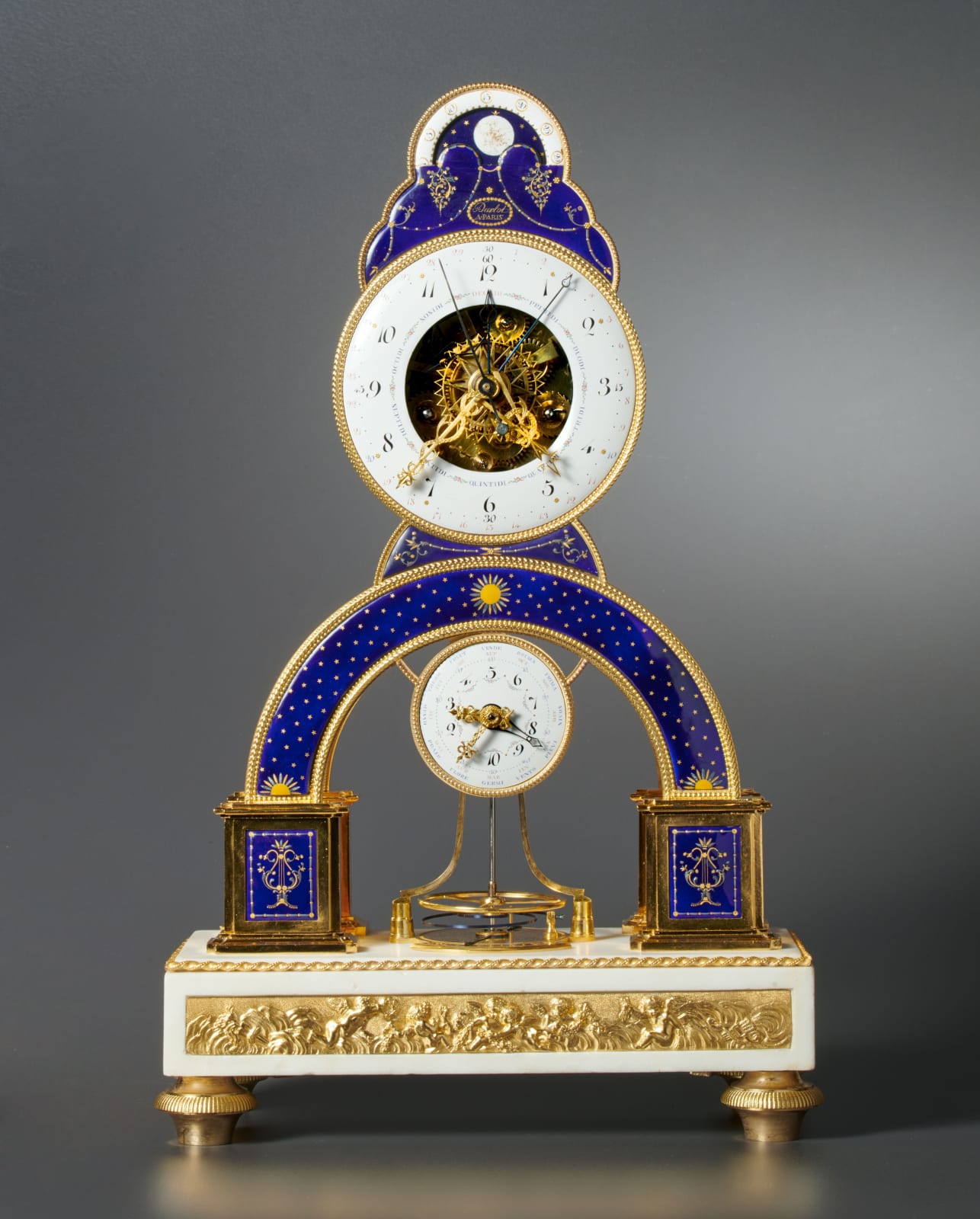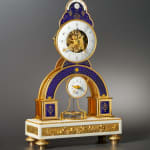Darlot (D’Arlot)
Further images
Literature
Pierre Kjellberg, “Encyclopédie de la Pendule Française du Moyen Age au XXe Siècle”, 1997, p. 324, pl. A, illustrating a similar Directoire skeleton clock by Bisson à Paris and very similar enamel dials by Joseph Coteau, in the Musée des Arts Décoratifs, Paris, featuring a similar arrangement of the many Revolutionary time indications on the dials and likewise with the balance wheel mounted on its white marble base.
A rare and extremely fine Directoire gilt bronze mounted blue enamel and white marble skeleton clock of eight day duration, signed within a gilded cartouche above the main dial Darlot à Paris with superb enamel work attributed to Joseph Coteau. The white enamel dial ring with an outer Republican calendar ring for the 30 days of the month, with black Arabic numerals for the days 10/ 20/30 while all other days in the month are with red Arabic numerals, also with Gregorian black Arabic hour and minute rings and an inner ring marked with the names of the Revolutionary days in each decailles, namely: Primidi/Duodi/Tridi/Quartidi/Quintidi/Sextidi/Septidi/Octidi/Nonidi/Décadi, each day interspersed with flowers and foliage. The main dial ring with blued steel pointers for the calendar indications and sweep centre seconds and an exceptionally beautiful pair of pierced gilt brass hands for the Gregorian hours and minutes, the hour hand to include dividers and a ribbon tied wreath, both symbols of the French Revolution and likewise the minute hand shaped as rope entwined around a spear. The dial with a cut-out centre to reveal the elaborate skeletonised movement with pin wheel escapement driven from below by a large balance wheel, mounted on the white marble base, with a blued steel pointer to regulate the speed, striking on the hour and half hour on a single bell, with outside count wheel. The main dial surmounted by a lunar dial with grisaille moon and outer ring marked with the 29 ½ days of the lunar calendar. The driving power for the top dial powering a subsidiary dial below. The latter smaller dial with an outer ring marked with the abbreviated names of the Republican year, beginning at top: Vende [September]/Bruma/Frima/Nivos/Pluvi/Vento/Germi/Flore/Prair/Messd/Therm/Fruct, under which are abbreviated names of the Gregorian months and two inner decimalised rings marked 1-10 and 10-100, respectively for the revolutionary hours and minutes with floral swags below each, with a blued steel pointer for the outer calendar indications and an extremely beautiful pair of gilt brass hands for the Republican hours and minutes, both shaped as a fasces. The gilt bronze mounted blue enamel arched frame decorated with gilded stars and floral and foliate sprays with each supporting arch on a rectangular gilt pilaster upon a rectangular white marble base centred by a gilt bronze frieze cast with numerous winged putti, supported on toupie feet
Paris, date circa 1793-95
Height 47 cm, width 29.5 cm, depth 14 cm.
This superb clock epitomises the new decimalised time system that was introduced in France during the French Revolution. It is very rare since very few clocks display such a broad spectrum of Republican time systems. On November 24th 1793 the National Convention instituted a decree stipulating that the metric system was to replace the Gregorian calendar which had been created by Pope Gregory XII in 1582. However, this new decimalised system proved so complicated that in April 1795 it was no longer obligatory and was finally abolished in 1806. The new Republican calendar still consisted of twelve months, but each only had 30 days. There was also an additional month of up to five days for a leap year. Months was divided into three décailles, each comprised of 10 days. The names of these 10 days can be seen on the inner ring on the main dial. Days were no longer divided into 24 hours but comprised 10 hours, each made up of 100 minutes and each minute divided into 100 seconds, as displayed on the lower subsidiary dial. These new divisions meant that the new revolutionary hour was equal to the normal length of two hours and twenty minutes. In addition to this the months were given new names based on nature, as shown on the lower dial. The first month Vendémaire (from the French word vendange meaning grape harvest) began on 22nd, 23rd or 24th September while the last month, which began on 18th or 19th August was Fructidor, from the Latin fructus meaning fruit.
In addition to the array of Republican time indications, the hands are also exquisitely fashioned to symbolise revolutionary emblems. Thus the hour hand on the main dial is shaped as a divider and encircled by a laurel leaf wreath while both of the gilt brass hands on the lower subsidiary dial are shaped as fasces. These were formed as bundles of rods enclosing an axe bound by a strap. Used in combat by Roman lictors, fasces were also emblems of higher Roman magistrates to signify their authority to scourge and behead. They were also a symbol of justice and adopted as symbols of the French Revolution. Very few clocks have such beautiful hands.
Mention should also be made of the beautiful enamel decoration. This compares closely with the work of Joseph Coteau (1740-1801), such as one now in the Musée des Arts Décoratifs, Paris illustrated in Pierre Kjellberg, op. cit.). Not only are the red and black Arabic Gregorian and Revolutionary numerals laid out in a similar fashion, but they are also adorned with similar floral swags. Originally from Geneva, Coteau worked primarily in Paris, where he was established in rue Poupée, St. André des Arts and was received as a maître in 1778. In 1780 he began doing piece work for the Manufacture Royale de Sèvres Porcelain while also working independently in Paris as a flower painter, specialising in enamelling watchcases and clock dials. However, he fell out with Sèvres over payments and thus his contract was terminated in 1784. As an independent artist, he supplied dials, plaques and painted cases to the leading Parisian clockmakers including Robert Robin and Ferdinand Berthoud, both clockmakers to Louis XVI. Coteau appears not to have enamelled watches nor small scale pieces but tended to specialise in larger works which were technically more complex due to shrinkage during firing. A Sèvres document states that he and Parpette (who also worked at the factory) introduced jewelled enamelling (a technique that involved enamelled gold-leaf foils) to both soft and hard paste porcelain. Coteau also experimented with various polychromes, producing a blue, such as we see here, that was so rare and difficult to perfect that few of his contemporaries managed to copy.
The maker of this ingenious clock was Darlot à Paris. Tardy lists a Louis XVI clock, presumably by the same maker signed ‘D’Arlot Horloger du Roy à Versailles as well as a multi-dial pendule portique signed on the movement Darlot and dated 1795. The latter clock, which is in the Musée Carnavalet, Paris, shows both the Republican and Gregorian time system (illustrated in Pierre Kjellberg, “Encyclopédie de la Pendule Française du Moyen Age au XXe Siècle”, 1997, p. 318, pl. A).







